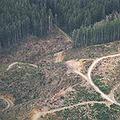 根據美國跨部會氣候變遷科學計畫首次發表的「碳循環狀態報告」,由於人為排放過高,北美的碳循環收支目前嚴重失衡。北美二氧化碳排放超過全球的25%,其中化石燃料轉換為能源使用佔最大宗,交通運輸則次之。
根據美國跨部會氣候變遷科學計畫首次發表的「碳循環狀態報告」,由於人為排放過高,北美的碳循環收支目前嚴重失衡。北美二氧化碳排放超過全球的25%,其中化石燃料轉換為能源使用佔最大宗,交通運輸則次之。
這些排放有半數可被森林等「碳匯」(Carbon “sinks”)所吸收,但氣候變化可能會讓原本的碳匯轉為新的碳源。報告主要作者之一的史丹佛卡內基科學中心教授菲德(Chris Field)指出,「人類燃燒化石燃料與砍伐森林,已經讓全球碳循環發生巨大改變。」
大氣中二氧化碳增加便是後果之一,但人為排放的二氧化碳中,至今有一大部份已被海洋、植物與土壤吸收。菲德認為,「這些碳循環中人類尚無法了解控制的部份,其實給我們極大的緩衝。」
整體而言,全球有超過2000億噸的碳被吸收儲存,而沒有進入大氣中。北美大陸最主要的碳匯機制,是森林從廢耕地重新生長,以及農田土壤的吸收。但隨著森林成熟老化與氣候狀態改變,這些碳匯的吸收力可能到達上限。氣候模擬也預測,若野火發生頻率升高,有的碳匯便可能付之一炬。
栽植森林與使用低碳排放的免耕農法,也許能稍微讓碳匯增加,但對於抵銷日益上升的碳排放,只算是杯水車薪。報告另一位作者卡戴拉(Ken Caldeira)表示,「復育森林與鼓勵更優良的農耕方式固然有許多好處,但要降低人類對碳循環的衝擊,仍須從大幅減少二氧化碳排放著手。」
發電是北美碳排放的主因,根據所能得到的最新資料,發電占美國2004年碳排放總量的94%,加拿大2003年的65%,墨西哥1998年的67%。
北美有超過半數的電力是被建築使用所消耗,建築也因此成為最大的碳排放源。在美國,建築物消耗67%的總電量,而且建築能耗會隨著商用建築與私人住宅面積加大而上升,隨著人口與收入成長,建築相關的碳排放預估會持續增多。
North America's carbon budget is increasingly overwhelmed by human-caused emissions, according to the first "State of the Carbon Cycle Report" for the continent, released online this week by the U.S. Climate Change Science Program.
The interagency government report finds North America's emissions of the greenhouse gas carbon dioxide are greater than 25 percent of global emissions. The conversion of fossil fuels to energy, such as electricity generation, is the single largest carbon contributor, with transportation second.
Carbon "sinks" such as growing forests may remove up to half this amount, but these current sinks may turn into new sources as climate changes. "By burning fossil fuel and clearing forests, human beings have significantly altered the global carbon cycle," says one of the report's lead authors Chris Field of the Carnegie Institution for Science's Department of Global Ecology in Stanford, California.
A result has been the buildup of carbon dioxide in the atmosphere, but so far this has been partially offset by carbon uptake by the oceans and by plants and soils on land. "In effect, we have been getting a huge subsidy from these unmanaged parts of the carbon cycle," says Field.
Overall, this subsidy has sequestered, or hidden from the atmosphere, approximately 200 billion tons of carbon. In North America much of it has come from the regrowth of forests on former farmland and the uptake of carbon by agricultural soils.
But these carbon sinks may be reaching their limit as forests mature and climate conditions change. Some may go up in smoke if wildfires become more frequent, as some climate simulations predict.
Planting forests and adopting carbon-conserving practices such as no-till agriculture may increase carbon sinks somewhat, but this would not come close to compensating for carbon emissions, which continue to accelerate.
"There are a lot of good reasons for replenishing our forests and encouraging better agricultural practices," says Ken Caldeira, another author of the report, also at Carnegie's Department of Global Ecology. "But if we want to mitigate our impact on the carbon cycle, there's no escaping the fact that we need to drastically reduce carbon dioxide emissions."
Electricity generation is responsible for the largest share of North America's carbon emissions - approximately 94 percent in the United Sates in 2004, 65 percent in Canada in 2003, and 67 percent in Mexico in 1998. These are the latest years for which data are available.
More than half of the electricity produced in North America is consumed in buildings, making that single use one of the largest factors in North American emissions. In the United States, 67 percent of all electricity generated is used in buildings.
In the United States, the major drivers of energy consumption in the buildings sector are growth in commercial floor space and increase in the size of the average home. Carbon emissions from buildings are expected to grow with population and income.
全文及圖片詳見 :ENS



